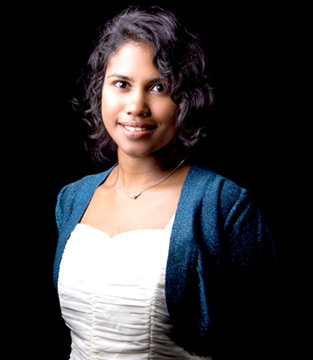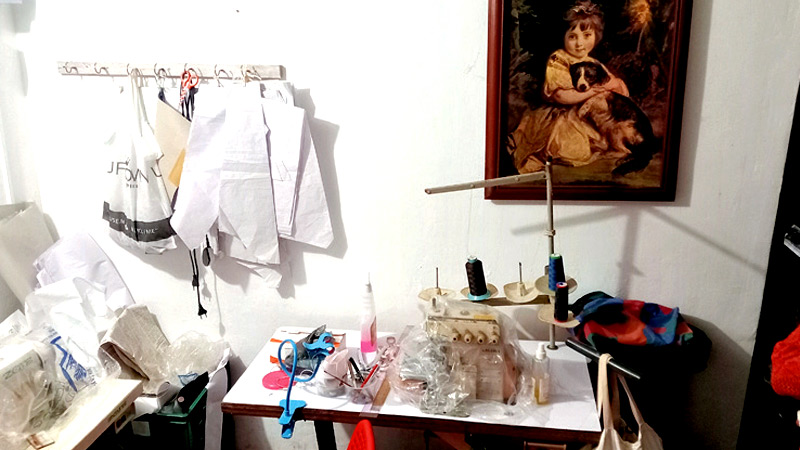
Devindi Gunarathne
The name Mishra means ‘mix’ in Sinhala and Devindi Gunarathne’s tiny workshop has all the hallmarks of a mix. Three Juki machines take up the corners and piles and piles of discarded garments occupy the centre. She holds up old clothes that had just arrived from her supplier – Zero Trash Collection Centre.
There were soiled polo T-shirts and faded sundresses; the basic building blocks of Mishra’s many creations. Due to high demand these days, she is mainly focusing on a line of pet beds that come in various sizes. “I’m getting a lot of orders these days,” she says. “Some of my clients want customised beds for their pets”. She’s also employed an 18-year-old recently making her a bona fide job creator.
Devindi is the creative anomaly in a family of doctors and lawyers. The ball started rolling in university in 2016 when Devindi took up her scissors, measuring tape and sewing machine to compete in a fashion event called ‘Mother and Daughter’. “I saw a lot of people throwing garments away, so I started collecting the discards,” she says and explained that this cache of discards came in handy the next year for a competition for young entrepreneurs. Her first products were cloth bags. Mishra began to take shape in 2019.
“At first I named my fashion line ‘Chroma’ but changed it to ‘Mishra’ so the name stands out internationally. The word Mishra has its roots in Sanskrit and complements the brand’s native image”.
Devindi explains that the textile industry is the second biggest polluter in the world today. Fast fashion is creating landfills by the day; contributing more to climate change than air and sea travel. Furthermore, toxic runoff from textile factories pollutes waterways in the global south which is racing to demand of fast fashion. “These are the reasons I wanted to make an upcycling line,” she says.

Pix – Stephano Whittall
There are many upcycling brands out there but a few do it with real discards; meaning most upcycling fashion lines just buy factory throwaways in bulk to churn out more and more stuff. Mishra procures its raw materials from Zero Trash, which collects throw away clothes. “People have asked why Mishra’ products have limited colours and textures. But this is because I work with actual throwaways. I don’t get to pick through a lot of colours,” she says.
Devindi further explained the difference between upcycling and downcycling. “Upcycling is taking discards and making them into a different and value added product while downcycling is making the same product; although called ‘recycling’ most recycling is actually downcycling, as many plastics lose their durability during the recycling process, resulting in a cheaper new product”. On the contrary, Devindi says she is making sustainable and durable products which won’t make more waste down the line.
Mishra’s pet bed line is the best seller and Devindi guarantees that they are good for five years. “They can last long unless your pets like to use them as chew toys,” she says with a smile. She agrees that pet beds are a niche market but her clientele have been very loyal. People are asking me to put my pet beds in veterinary clinics and I’m getting a lot of orders. There are also plans to make the products available for purchase online”. Devindi also has ideas to export Mishra products.
Devindi’s journey with Mishra is not just a story of creativity but also a remarkable example of environmental consciousness and innovation. In a world dominated by fast fashion and mass production, Devindi’s dedication to upcycling discarded materials not only reduces the environmental footprint of the textile industry but also results in beautifully crafted, durable, and sustainable products.
Mishra isn’t just a brand; it’s a movement towards a more sustainable and responsible fashion industry.
As Devindi explores opportunities to export Mishra products, she’s not only envisioning success for her brand but also sharing her values with the world. Her journey reminds us that each one of us can make a positive impact, and it’s through dedicated individuals like Devindi that we can collectively make a difference. Mishra is a beacon of hope for a more sustainable future in fashion, one that encourages us all to think creatively, be mindful of our environment, and pursue our passions with a purpose.









